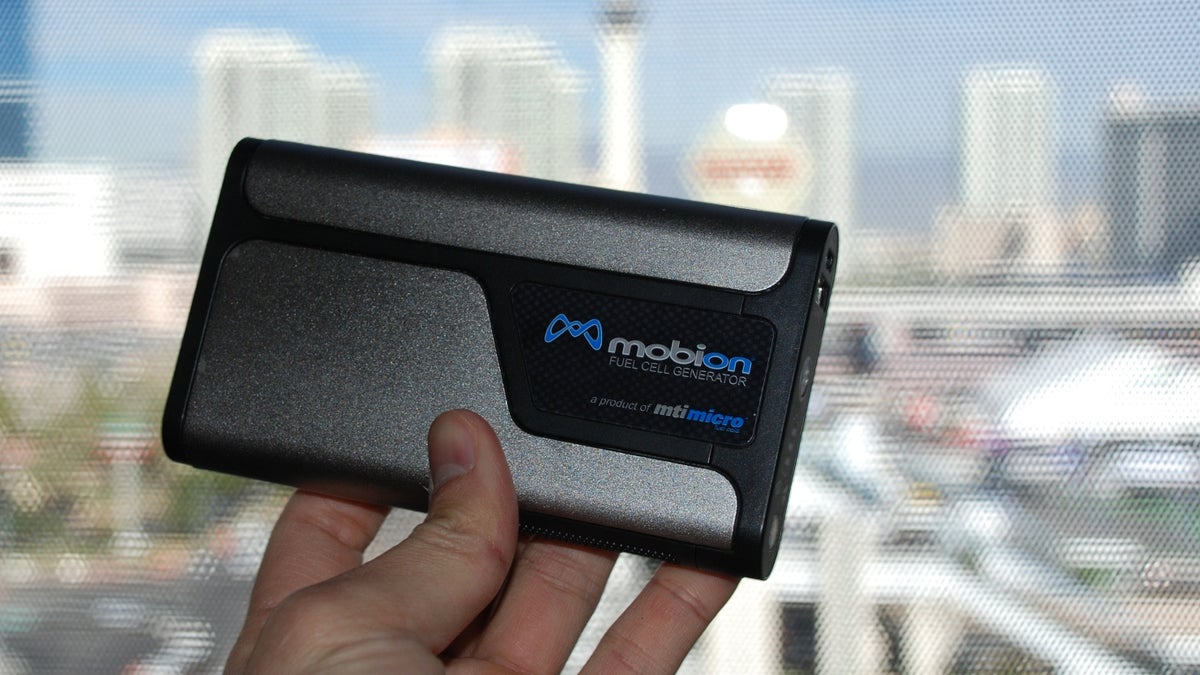Fuel cell portable charger works, still needs more work
CNET's Dong Ngo recaps his personal experience with using the Mobion Fuel Cell Generator during CES 2011.

LAS VEGAS--I had some hands-on experience with the Mobion Fuel Cell Generator in December and decided to bring it with me to CES 2011 with the intention of using it as the only charger for my iPhone 4 and seeing how this green technology would work out.
In case you're anxious, it worked out OK, though not perfectly.
Prior to the trip, MTI Micro, the device's maker, told me that while the generator itself would pose no problem, the fuel cell cartridge, which contains the fuel liquid, has not been approved to be included with carry-on luggage so I should leave it at home. I brought both with me anyway and was able to go through the Oakland airport's security with no issue. When I arrived in Las Vegas, MTI delivered two more cartridges to make sure I could charge my phone during the entire show.
I used the charger the way I would charge my phone normally: whenever possible. I carried it in my backpack and would take it out to charge the phone when I was not moving around. But as I moved around too much, by the time I got back to the hotel after the first day of the show, the phone's battery was down to just 20 percent. Clearly, if I hadn't had the charger with me, the phone would have died before the day was through.
As I got the charger out of the backpack, I noticed two things. First, it was really warm as it had been running nonstop. This was rather astonishing as I remember turning it off. As it turns out, the generator seems to insist on running until it's done with charging its internal battery. This internal battery serves as the buffer that charges the phone. In other words, the generator doesn't charge the iPhone directly. (By the way, to turn the charger off you have to press the button for a few seconds and then leave it to turn itself off, much as you click on the shutdown button to turn a computer off.)
According to MTI, the fuel cell engine generates about 1 watt of power constantly, while the iPhone requires about 2.5 watts to charge. This makes it impossible for the engine to charge the phone directly.
The second thing I noticed was that the engine made some noise, which, interestingly, sounded like a muffled version of a real gas generator, which I found kind of cute at first. Though it's not loud enough to notice in a room with a normal amount of ambient noise, in a quiet hotel room at night, it was enough to be somewhat annoying. So I decided to plug my phone into the device, moved the whole thing to the restroom, closed the door, and let it run overnight to charge the phone.
The next morning, I found that the first cartridge was almost completely empty, while both the iPhone and the internal battery were fully charged. I called MTI and found out that the engine wouldn't stop by itself and will keep burning the fuel even when there's nothing else to charge. This is a huge bug in my opinion.
Note that the generator is just a prototype, which means it needs more work and, in this case, a lot more work, to be user-friendly. Jim Frawley, MTI's director of business development, told me that the Mobion Fuel Cell Generator, as it's designed to be used only for field-testing purposes, for now requires some "training" before it can be used effectively. And after a brief training session with him, I was able to use it for the rest of the show without any further issues.
Apart from the first cartridge that was drained by accident, I used up just a tiny bit of the second cartridge for the rest of the show, leaving the third cartridge untouched.
TSA officers at Las Vegas' airport were intrigued by the Mobion Fuel Cell Generator and especially by the two IoSafe Rugged Portable drives, one of which was full of gunshot holes; the agent asked me to wait for a bit to check them out. After a few minutes they were impressed and let me go.
Judging from how it worked out for me, the Mobion Fuel Cell Generator is still far from being fine-tuned enough for general consumers. When all that's done, hopefully by CES 2012, however, it could make an exciting product that changes the way we charge our portable electronics.

